India Posts
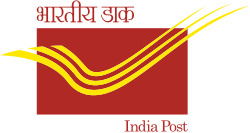 | |
Native name |
India Post भारतीय डाक |
|---|---|
| Agency of the Government of India | |
| Industry | Postal services, courier |
| Founded | 1 April 1774 |
| Headquarters | Sansad Marg, New Delhi- 110001 |
Key people | Smt. Padmini Gopinath, Director General |
| Services | Letter post, parcel service, EMS, delivery, freight forwarding, third-party logistics, deposit account |
Number of employees | 466,903 (As of 31 March 2011)[1] |
| Slogan | Dak Seva Jan Seva |
| Website |
www |

The Department of Posts, trading as India Post, is a government-operated postal system in India; it is generally referred to within India as "the post office".
As of 31 March 2011, the Indian Postal Service had 154,866 post offices, of which 139,040 (89.78 percent) were in rural areas and 15,826 (10.22 percent) in urban areas. It had 25,464 departmental Post Offices and 129,402 Extra-Departmental Branch Post Offices. At the time of independence, there were 23,344 post offices, primarily in urban areas. The network has registered a sixfold growth since independence, with the expansion's focus primarily in rural areas. On average, a post office serves an area of 21.23 square kilometres (8.20 sq mi) and a population of 7,114; it is the most widely distributed postal system in the world.[1] The large number is a result of a tradition of disparate postal systems, which were unified in the Indian Union after independence. Because of this far-flung reach and its presence in remote areas, the Indian postal service is also involved in other services (such as small-savings banking and financial services).
The postal service is under the Department of Posts, which is part of the Ministry of Communications and Information Technology of the Government of India. The apex body of the department is the Postal Service Board, consisting of a chair and six members. The six board members govern personnel, operations, technology, postal life insurance, human-resource development (HRD) and planning. The joint secretary and financial adviser is also a permanent invitee.
India has been divided into 22 postal circles, each circle headed by a chief postmaster general. Each circle is divided into regions, headed by a postmaster general and comprising field units known as divisions (headed by SSPOs and SPOs). These divisions are further divided into subdivisions, headed by ASPs and IPOs. Other functional units (such as circle stamp depots, postal store depots and mail motor service) may exist in the circles and regions. In addition to the 22 circles, there is a base circle to provide postal services to the Armed Forces of India. The base circle is headed by a Director General, Army Postal Service (with a rank of major general).
The highest post office in the world is in Hikkim, Himachal Pradesh, India at a height of 15,500 ft (4,700 m) (postal code 172114).[2]
History
Posts and the British Raj (1858–1947)
The British Raj was instituted in 1858, when the rule of the East India Company was transferred to the Crown.[3] By 1861, there were 889 post offices handling nearly 43 million letters and over 4.5 million newspapers annually. The first superintendent of the post office was appointed in 1870 and based in Allahabad. In 1876, British India became the first non-founding member of the General Postal Union.
A number of acts were passed during the British Raj to expand and regulate Posts and Telegraphs service:
- The Government Savings Bank Act 1873 (5 of 1873), passed by the legislature 28 January 1873, was enacted in 1881. On 1 April 1882, Post Office Savings Banks opened throughout India (except in the Bombay Presidency). In Madras Presidency, it was limited; in the Bengal Presidency, no POSBs were established in Calcutta or Howrah.
- Postal life insurance began on 1 February 1884 as a welfare measure for the employees of the Posts & Telegraphs Department as Government of India dispatch No. 299 dated 18 October 1882 to the Secretary of State.
- Telegraph Act, 1885 (Indian Telegraph Act)
- The Indian Post Office Act 1898 (6 of 1898), passed by the legislature on 22 March 1898, became effective on 1 July 1898 regulating postal service. It was preceded by Act III of 1882 and Act XVI of 1896.
- The Indian Wireless Telegraphy Act 1933 (17 of 1933)
The world's first official airmail flight took place in India on 18 February 1911, a journey of 18 kilometres (11 mi) lasting 27 minutes. Henri Pequet, a French pilot, carried about 15 kilograms (33 lb) of mail (approximately 6,000 letters and cards) across the Ganges from Allahabad to Naini; included in the airmail was a letter to King George V of the United Kingdom.[4] India Post inaugurated a floating post office in August 2011 at Dal Lake in Srinagar, Kashmir.[5]
Telegraphy and telephony made their appearance as part of the postal service before becoming separate departments. The Posts and Telegraphs Departments merged in 1914, dividing on 1 January 1985.
Post-independence service

Since Indian independence in 1947 the postal service continues to function on a nationwide basis, providing a variety of services. The structure of the organisation has the Directorate at its apex; below it are Circle Offices, Regional Offices, the Superintendent's Office of Post Offices, Head Post offices, Sub-Post Offices and Branch Post Offices. In April 1959, the Indian Postal Department adopted the motto "Service before Self"; it revised its logo in September 2008.[6]
Postage-stamp history
First adhesive stamps in Asia

.jpg)
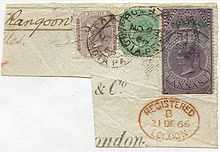
The first adhesive postage stamps in Asia were issued in the Indian district of Scinde in July 1852 by Bartle Frere, chief commissioner of the region.[7] Frere was an admirer of Rowland Hill, the English postal reformer who had introduced the Penny Post. The Scinde stamps became known as "Scinde Dawks"; "Dawk" is the Anglicised spelling of the Hindustani word Dak or ("post"). These stamps, with a value of 1⁄2-anna, were in use until June 1866. The first all-India stamps were issued on 1 October 1854.
EIC stamps issued after 1866
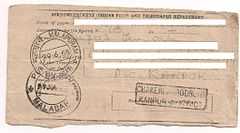
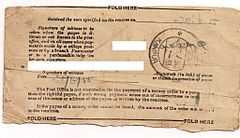
The volume of mail moved by the postal system increased significantly, doubling between 1854 and 1866 and doubling again by 1871. The Post Office Act XIV introduced reforms by 1 May 1866 to correct some of the more obvious postal-system deficiencies and abuses. Postal-service efficiencies were also introduced. In 1863, lower rates were set for "steamer" mail to Europe at (six annas, eight pies for a 1⁄2-ounce letter). Lower rates were also introduced for inland mail.
New regulations removed special postal privileges enjoyed by officials of the East India Company. Stamps for official use were prepared and carefully accounted for, to combat abuses by officials. In 1854 Spain had printed special stamps for official communications, but in 1866 India was the first country to adopt the expedient of overprinting "Service" on postage stamps and "Service Postage" on revenue stamps. This innovation was later widely adopted by other countries.[8]
Shortages developed, so stamps also had to be improvised. Some "Service Postage" overprinted rarities resulted from abrupt changes in postal regulations. New designs for the four-anna and six-anna-eight-pie stamps were issued in 1866. Nevertheless, there was a shortage of stamps to meet the new rates. Provisional[9] six-anna stamps were improvised by cutting the top and bottom from a current foreign-bill revenue stamp and overprinting "Postage".
India was the first country in the Commonwealth to issue airmail stamps.
Post-independence stamps
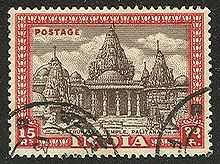

India attained independence on 15 August 1947. Thereafter, the Indian Posts and Telegraph Department embarked on a broad-based policy for the issuance of stamps. The first new stamp was issued by independent India on 21 November 1947. It depicts the Indian flag with the patriots' slogan, Jai Hind ("long live India"), at the top right-hand corner. The stamp was valued at three and one-half annas.
A memorial to Mahatma Gandhi was issued 15 August 1948 on the first anniversary of independence. One year later a definitive series appeared, depicting India's broad cultural heritage (primarily Hindu, Buddhist, Muslim, Sikh and Jain temples, sculptures, monuments and fortresses). A subsequent issue commemorated the beginning of the Republic of India on 26 January 1950.
Definitives included a technology-and-development theme in 1955, a series depicting a map of India in 1957 (denominated in naya paisa—decimal currency) and a 1965 series with a wide variety of images. The old inscription "India Postage" was replaced in 1962 with "भारत INDIA", although three stamps (issued from December 1962 to January 1963) carried the earlier inscription.[10]
India has printed stamps and postal stationery for other countries, mostly neighbours. Countries which have had stamps printed in India include Burma (before independence), Nepal, Bangladesh, Bhutan, Portugal and Ethiopia.[11] The country has issued definitive and commemorative stamps. Six definitive series on India's heritage and progress in a number of fields have been issued. The seventh series, with a theme of science and technology, began in 1986. Between independence and 1983, 770 stamps were issued.
Philately
Functions
- Design, printing and distribution of special or commemorative postage stamps
- Design, printing and distribution of definitive postage stamps and items of postal stationery (such as envelopes, inland-letter cards, postcards, aerograms and registered covers)
- Promotion of philately, conduct of philatelic examinations at the national level, participation in international exhibitions and monitoring exhibitions at the state, regional and district levels
- Maintenance of the National Philatelic Museum (Dak bhawan)
The first philatelic Society in India was founded in Bombay on 6 March 1897 to service postage-stamp collections.
Philatelic bureaus
Philatelic bureaus were established in head post offices located at circle headquarters and at district-capital head post offices (as necessary). There are 68 philately bureaus and 1111 philatelic counters, including all head post offices (Mukhya Dak Ghars) in the country as of 31 March 2011.[12]:44
A domestic philatelic deposit-account system was introduced on 1 August 1965 at all philatelic bureaus. Customers are given priority in purchasing commemorative or special-issue stamps, first-day covers and information sheets soon after their issue by opening a deposit account at any philatelic bureau. The number of philately deposit-accountholders grew from 23,905 in 1999–2000 to 168,282 in 2006–2007 and 183,202 in 2008–2009. Four philatelic Bureaus—the Bombay, Madras, Calcutta and Parliament Street, New Delhi GPOs are authorised to sell United Nations stamps. A quarterly philatelic magazine, Philapost, was launched in 2008.
The Department of Post has also developed software for philatelic inventory management, known as "Philsim". It is used for all activities relating to philately, including forecasting, indenting, invoicing, monitoring supply and demand and recording sales and revenue for commemorative stamps and other philatelic products at philately bureaus and counters (and definitive stamps and stationery at circle stamp depots and head post offices).
Army Postal Service
National Philatelic Museum

The National Philatelic Museum of India was inaugurated on 6 July 1968 in New Delhi. It had its beginnings at a meeting of the Philatelic Advisory Committee on 18 September 1962. Besides a large collection of India Postage stamps designed, printed and issued, it has a large collection of Indian states (confederate and feudatory), early essays, proofs and colour trials, a collection of Indian stamps used abroad, early Indian postcards, postal stationery and thematic collections. The museum was renovated in 2009 with more exhibits, a philatelic bureau and postal objects (such as Victorian post boxes). The Department of Posts inaugurated the National Philatelic Museum on 11 July 2011. It exhibits rare postage stamps from around the world and provides a venue for philatelists to exhibit their collections.
Postal life insurance
Due to the popularity of postal life insurance, it was offered to other departments of the central and state governments. Postal life insurance is available to employees of all central- and state-government departments, nationalised banks, public-sector and financial institutions, local municipalities, district councils and educational institutions receiving government subsidy. It was extended to all rural residents on 24 March 1995.
Life insurance
Policies for government employees include:[13]
- Santhosh (endowment assurance)
- Suraksha (whole-life assurance)
- Suvidha (convertible whole-life assurance)
- Sumangal (anticipated endowment policy)
- Yugal Suraksha (joint life endowment assurance)
For the general public:
- Gram Santosh (endowment assurance)
- Gram Suraksha (whole-life assurance)
- Gram Suvidha (convertible whole-life assurance)
- Gram Sumangal (anticipated endowment assurance)
- Gram Priya (10-year RPLI)
- Children's policies
Project Arrow
Project Arrow was launched in April 2008.[6] The project plans to upgrade post offices in urban and rural areas, improving service and appearance. The project aims to create an effective, friendly environment for staff and customers, providing secure IT services and improving mail delivery, remittances (electronic and manual) and postal-savings plans. Core areas for improvement are branding, information technology, human resources and infrastructure. The project to improve service has been implemented in more than 15,500 post offices, and cosmetic improvements have been made in 1,530. The Department of Posts received the Prime Minister’s Award for Excellence in Public Administration during 2008–09 for “Project Arrow – Transforming India Post” on 21 April 2010.[14]

Technology
The government has approved an IT modernisation project in the Department of Posts for the computerisation of all post and mail offices, administrative and other offices, establishment of IT infrastructure and software development. The project includes supplying rural ICT hardware and peripherals to branch post offices in rural areas, developing of scalable, integrated and modular software covering all postal operations and establishing an IT infrastructure; including data centers and Wide Area Network (WAN)-based networking.
Computerization
Multipurpose counter machines with computers were introduced in post offices in 1991 to:
- Improve customer service and increase revenue and staff productivity
- Make the post office the focal point for delivery of state social-security programs
- Enable the electronic networking of about 1,30,000 rural post offices
- Enable paperless transactions for mail, postal banking and insurance services
- Enable tracking and tracing of articles intended for delivery
25,000 departmental post offices (out of 25,464) have been computerised from 2006–2007 to 2011–2012. A plan (costing Rs.1877.2 crore) has been formulated to computerise rural post offices.[15]
Electronic Indian Postal Order
The Electronic Indian Postal Order (e-IPO) was introduced on 22 March 2013, initially only for citizens living abroad. The postal orders can be used for online payment of fees for access to information under the RTI Act of 2005. The service was expanded to include all Indian citizens on 14 February 2014.[16]
Financial services
Postal savings
The post office offers a number of savings plans, including National Savings Certificates,[17] the Public Provident Fund,[18] savings-bank accounts,[17] monthly-income plans,[17] senior-citizens' savings plans[18] and time-deposit accounts.[18]
Banking
In 2013 it was revealed that the Indian postal service had formulated plans to enter the banking industry after RBI guidelines for the issuance of new banking licenses were released.[19] Eventually they are planning to open a Post Bank of India, an independent banking service.[20]
Other services
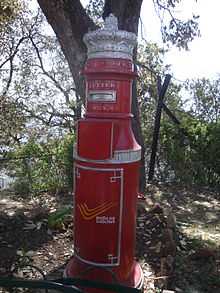

The post office has traditionally served as a financial institution for millions of people in rural India. Other services include:
- Post boxes and post bags for mail receipt
- Identity cards for proof of residence
Data collection
A collaboration between the Ministry of Statistics and Programme Implementation (MOS&PI) and the Department of Posts has enabled the computation of consumer-price indices for rural areas. These statistics were previously unobtainable, due to problems of remoteness and scale. The agreement authorises the postal service to collect data on prices paid for selected consumer goods; in February 2011, MOS&PI published its first Rural Consumer Price Index and All-India Consumer Price Index. The information has since been published monthly, based on data from 1,181 villages across the country.[1]
Revenue
The following table shows income generated by the postal department.[21]
| Year | Net expenditure ( in crore ) | Revenue (in crore) |
|---|---|---|
| 2010-11 | 13308.0 | 6962.3 |
| 2011-12 | 13705.3 | 7899.4 |
| 2012-13 | 14792.4 | 9366.5 |
PIN codes
The Postal Index Number (PIN, or PIN code) is a six-digit code of post-office numbering introduced on 15 August 1972. There are nine PIN regions in the country; the first eight are geographical regions, and the ninth is reserved for the Army Postal Service. The first digit indicates the regions; the first two digits indicate the sub-region (or postal circle); the first three digits indicate a sorting district, and the last three digits indicate the delivery post office. Use of PIN codes improves mail service.[22] The PIN for an address may be found on the Postal Service website.[23] There are total of 19101 PIN codes and it covers 154725 Post Offices in India except the Army Postal Service as of 2014.[24][25]
Controversy
India Post was embroiled in controversy when a Right to Information query by Dr Satendra Singh of Enabling Unit revealed that a majority of post offices in India's capital city are inaccessible to persons with disabilities.[26][27][28][29]

See also
References
- ↑ 1.0 1.1 1.2 http://www.indiapost.gov.in/Report/Annual_Report_2011-2012.pdf
- ↑ "World's Highest Post Office". Stamps of India. Retrieved 24 April 2011.
- ↑ Kaul, Chandrika. "From Empire to Independence: The British Raj in India 1858–1947.". Retrieved 3 March 2011.
- ↑ "The world's highest post office!". Rediff India. Retrieved 24 April 2011.
- ↑ Indo-Asian News Service (2011-08-22). "Srinagar gets floating post office". The Times of India. Retrieved 2012-06-07.
- ↑ 6.0 6.1 http://www.indiapost.gov.in/Report/Annual_Report_2008-2009.pdf
- ↑ http://web.archive.org/web/20091027143019/http://www.geocities.com/mjshah.geo/scinde/scinde.html
- ↑ Alan C. Campbell, "The Design Evolution of the United States Official Stamps", U.S. Philatelic Classics Society Chronicle, Vol. 48, Nos. 1 and 2, Whole Nos. 169 and 170 (February and May,1996).
- ↑ Linns.com Refresher Course
- ↑ Saksena, V. ibid., p. 84.
- ↑ Saksena, V. (1989), pp. 86–8.
- ↑ "Annual Report 2010-2011" (PDF). www.indiapost.gov.in. Retrieved 7 October 2012.
- ↑ "Customer Portal". Postal Life Insurance. Retrieved 2012-06-07.
- ↑ .^ http://www.indiapost.gov.in/Report/Annual_Report_2011-2012.pdf
- ↑ "India News in Hindi, Latest Hindi News Punjab & World News, Hindi Newspaper". Punjabkesari.in. Retrieved 2012-06-07.
- ↑ "RTI Process gets Further Boost with the Introduction of ‘e-Indian Postal Order’ for all by the Department of Posts" (Press release). PIB. 13 February 2014. Retrieved 16 February 2014.
- ↑ 17.0 17.1 17.2 http://www.indiapost.gov.in/Old/Pdf/SB_Orders_01-01-2011.pdf
- ↑ 18.0 18.1 18.2 "Welcome to the Indiapost Web Site". Indiapost.gov.in. Retrieved 2012-06-14.
- ↑ "Coming soon, Post Bank of India". The Hindu. 2013-02-23. Retrieved 2013-02-25.
- ↑ "Post Bank" (Press release). Press Information Bureau , Government of India. 14 August 2013. Retrieved 14 August 2013.
- ↑ "Revenue of Postal Department". PIB. 19 February 2014. Retrieved 21 February 2014.
- ↑ punjab kesri- bal kesri dtd 7 Jan 2012
- ↑ "Welcome to the Indiapost Website". Indiapost.gov.in. Retrieved 2012-08-04.
- ↑ http://infoknown.com/pincode/blogroll/6/Do-you-know-the-total-number-of-PIN-Codes-in-INDIA
- ↑ http://infoknown.com/pincode/blogroll/19/Do-you-know-the-total-number-of-POST-Offices-in-INDIA
- ↑ "No ease of access to post offices for disabled". The Times Of India Delhi. 29 Oct 2012. Retrieved 17 November 2012.
- ↑ "Many post offices not accessible to disabled, reveals RTI query". The Hindu. 12 Nov 2012. Retrieved 17 November 2012.
- ↑ "Capital shocker: Post offices lack facilities for disabled". The Statesman. 5 Nov 2012. Retrieved 17 November 2012.
- ↑ Bhalla, Jaya Shroff (2 Dec 2012). "Access denied: Delhi not for disabled". The Hindustan Times.
Further reading
- Headrick, Daniel. "A double-edged sword: Communications and imperial control in British India." Historical Social Research/Historische Sozialforschung (2010): 51-65. in JSTOR
- Majumdar, Mohini Lal. The imperial post offices of British India, 1837-1914 (Phila Publications, 1990)
- Rahman, Siddique Mahmudur. "Postal Services During The East India Company's Rule In Bengal." Bangladesh Historical Studies 19 (2002): 43+
| Wikimedia Commons has media related to Post of India. |
External links
rahul anand